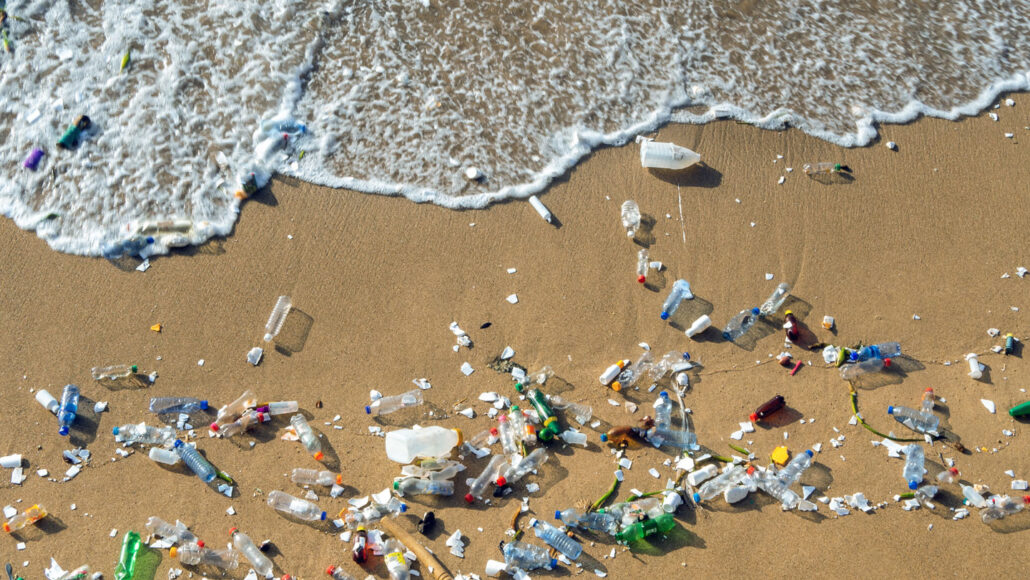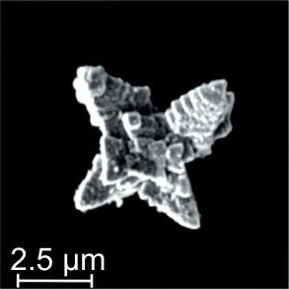Tiny swimming robots may help clean up a microplastics mess
Self-propelled machines can collect or break down plastic bits that pollute waterways

The plastics that washed up on this beach will break down into small pieces, known as microplastics, and scatter throughout the environment. A new type of microrobots may one day help to cleanup all those tiny plastic bits.
Mario De Moya F/iStock/Getty Images Plus
To tackle a big environmental problem, chemists in the Czech Republic have been thinking small. Really small. Their new miniature robot has one purpose: To help clean up tiny bits of plastic polluting waterways across the globe.
Each new microrobot is no bigger than the tip of a sharpened pencil. They are magnetic and shaped like stars. When sunlight hits them, they produce chemical reactions that propel them through water in a specific direction. When they find a piece of plastic, they glom onto it and start to break it down. When the lights go out, they let go and are free to be used again.
In a new study, the scientists reported that these robots can either break down a piece of microplastic or hold onto it to be collected later.
“This work is great,” says Douglas Blackiston at Tufts University in Medford, Mass. He’s a biologist who did not work on the project but knows about such devices. He’s been designing robots out of living cells, including some that might help with pollution cleanup. Speaking of the new one, he notes that “these robots can eat plastic. They chew it up. Or they can retrieve it and be collected with a magnet. Scientists love robots with all these capabilities.”
Chemist Martin Pumera at the Czech University of Chemistry and Technology in Prague led the project. He studies ways to build microrobots. About a decade ago, he notes, scientists began developing tiny ‘bots that could move themselves in water. Then, they had to find them a mission. He says they thought: “Let’s make them do something useful.”
Pumera chose to focus on the problem posed by microplastics.
It’s a big problem. These are tiny bits of plastic, usually no wider than the top of a pencil eraser. And they’re everywhere — from the bottom of the ocean to air blowing onto ice atop mountains. They’ve turned up in drinking water, both bottled and tap water. Some studies estimate that trillions of pieces of plastic end up in the world’s waters. The plastic has many sources, from drinking straws and shopping bags to laundry and cleaning wipes. (Just think about how much plastic you encounter every day.) Plastic doesn’t easily degrade or fall apart. That’s always been one of its appeals.
“We have a big plastic pollution problem now,” says chemist Sherri “Sam“ Mason at Pennsylvania State University Behrend, in Erie. Using less plastic is the most important step, she says. After that, she says, comes cleanup. This is where she sees a role for Pumera’s robots. “I’m encouraged,” she says. They’re “a really interesting idea to help with cleanup efforts down the road.” Like Pumera, she notes that the robots aren’t yet ready to be widely deployed.
Pumera says his ultimate goal is to make cheap and environmentally-friendly robots that can be used anywhere in the world. He suspects that at first they might be most useful in plants that treat wastewater. There they can remove plastic before it reaches open water.
His group is not there yet. But in the June 2 ACS Applied Materials & Interfaces, they report getting close.
Making microplastics appetizing
Their design has two main ingredients. The first is bismuth vanadate. It undergoes chemical reactions and “swims” when exposed to sunlight. Pumera’s team uses chemical reactions driven by light to break down plastic. To do this, they coated the bismuth material with a magnetic film. That lets it collect the robots later — so pollutant-eating ‘bots will not just become more pollution.
In lab experiments, the star-shaped swimmers glommed onto each of four different types of plastic. And after a week exposed to light, the robots had reduced the weight of the plastics. It wasn’t much — only by 3 percent. But that was an indication they were breaking the plastic down.

They also caused the surface of the plastics to change from smooth to pitted. That’s another sign the robots were degrading it. Finally, the scientists showed that magnets could attract and retrieve the ‘bot troops at the end of the experiment — along with their plastic captives. Pumera says that they want to make the tiny garbage collectors reusable. They are also testing new robots that only swim at a certain depth; that would make them easier to recover.
The new study is a proof of concept type. That means it shows something can be done successfully, even if it’s only on a small scale.
In fact, Pumera says they still have a long way to go. There are many types of plastics. And even these microrobots are unlikely to succeed in degrading them all.
The researchers also have not yet shown how safe this system is for the environment, although Pumera says that’s their next goal. The first real-world test will be in a wastewater-treatment plant.
Indeed, says Blackiston, “They’ll need a lot of testing to show that they’re safe in open waterways,” such as at sea.
But he thinks that these challenges can be overcome. And one day, microrobots could play a big role in a worldwide cleanup effort. “The race is on among scientists,” he says. “We’re working on this problem from lots of different angles.”
This story is one in a series presenting news on technology and innovation, made possible with generous support from the Lemelson Foundation.







